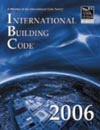SECTION
1104 ACCESSIBLE ROUTE
1104.1
Site arrival points. Accessible routes within the site
shall be provided from public transportation stops; accessible
parking; accessible passenger loading zones; and public
streets or sidewalks to the accessible building entrance
served.
Exception: Other than in buildings or facilities containing
or serving Type B units, an accessible route shall not be
required between site arrival points and the building or
facility entrance if the only means of access between them
is a vehicular way not providing for pedestrian access.
1104.2 Within a site. At least one accessible route
shall connect accessible buildings, accessible facilities,
accessible elements and accessible spaces that are on the
same site.
Exception: An accessible route is not required between
accessible buildings, accessible facilities, accessible
elements and accessible spaces that have, as the only means
of access between them, a vehicular way not providing for
pedestrian access.
1104.3 Connected spaces. When a building or portion
of a building is required to be accessible, an accessible
route shall be provided to each portion of the building,
to accessible building entrances connecting accessible pedestrian
walkways and the public way.
Exception: In assembly areas with fixed seating required
to be accessible, an accessible route shall not be required
to serve fixed seating where wheelchair spaces or designated
aisle seats required to be on an accessible route are not
provided.
1104.3.1 Employee work areas. Common use circulation
paths within employee work areas shall be accessible routes.
Exceptions:
1.
Common use circulation paths, located within employee
work areas that are less than 300 square feet (27.9
m2) in size and defined by permanently installed
partitions, counters, casework or furnishings, shall
not be required to be accessible routes.
2.
Common use circulation paths, located within employee
work areas, that are an integral component of equipment,
shall not be required to be accessible routes.
3.
Common use circulation paths, located within exterior
employee work areas that are fully exposed to the weather,
shall not be required to be accessible routes.
1104.3.2 Press boxes.
Press boxes in assembly areas shall be on an accessible
route.
Exceptions:
1.
An accessible route shall not be required to press boxes
in bleachers that have points of entry at only one level,
provided that the aggregate area of all press boxes is
500 square feet (46 m2) maximum.
2.
An accessible route shall not be required to free-standing
press boxes that are elevated above grade 12 feet (3660
mm) minimum provided that the aggregate area of all press
boxes is 500 square feet (46 m2) maximum.
1104.4 Multilevel buildings and facilities. At least
one accessible route shall connect each accessible level,
including mezzanines, in multilevel buildings and facilities.
Exceptions:
1.An
accessible route is not required to stories and mezzanines
above and below accessible levels that have an aggregate
area of not more than 3,000 square feet (278.7 m2).
This exception shall not apply to:
1.1. Multiple tenant facilities
of Group M occupancies containing five or more tenant
spaces;
1.2.
Levels containing offices of health care providers (Group
B or I); or
1.3.
Passenger transportation facilities and airports (Group
A-3 or B).
2.
In Group A, I, Rand S occupancies, levels that do not
contain accessible elements or other spaces required by
Section 1107 or 1108
are not required to be served by an accessible route from
an accessible level.
3.
In air traffic control towers, an accessible route is
not required to serve the cab and the floor immediately
below the cab.
4.
Where a two-story building or facility has one story with
an occupant load of five or fewer persons that does not
contain public use space, that story shall not be required
to be connected by an accessible route to the story above
or below.
1104.5 Location. Accessible routes shall coincide with
or be located in the same area as a general circulation
path. Where the circulation path is interior, the accessible
route shall also be interior. Where only one accessible
route is provided, the accessible route shall not pass through
kitchens, storage rooms, restrooms, closets or similar spaces.
Exceptions:
1.
Accessible routes from parking garages contained within
and serving Type B dwelling units are not required to
be interior.
2.
A single accessible route is permitted to pass through
a kitchen or storage room in an Accessible, Type A or
Type B dwelling unit.

